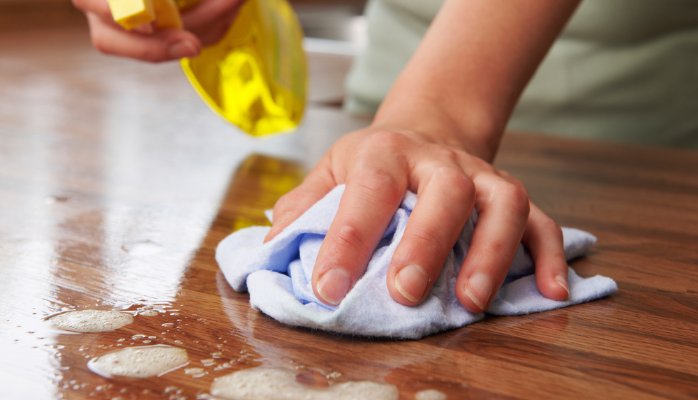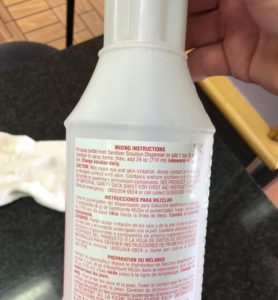
After a recent café experience I thought I’d write this short post to raise awareness to a problem that many people wouldn’t think twice about.
It occurred to me that many people are oblivious to how they use their cleaning chemicals.What’s more, blind loyalty to a cleaner who uses harsh chemicals can do more harm than good, which is something I’ve written about before.
In my local café, a lady was cleaning the tables around me with a spray and wipe chemical. I couldn’t tell you what was in the bottle as it was unlabelled, which is a safety concern in itself. I guess because I don’t use chemicals around my home I found the smell particularly offensive, especially while I was eating.
Did you know that breathing in chemicals is not the only way that they enter our bodies? Chemicals can also enter our system through our skin by touch and ingested by mouth.
Chemicals that have just been sprayed on a table sit there as a residue attracting more germs. Place your hand on the table, touch your food and they go in your mouth.


I found this sanitiser unattended in a fast food restaurant. Note the warning label.
Have you ever noticed the unsightly swirly patches of streaks on a table top when the light hits at a certain angle?
Have you ever placed your arms on a table only to find the surface sticky?
Have you noticed sticky floors with chemical swirls or even footprints?
Fingerprints in lifts?
Streaks in windows?
All of the above are the result of chemical residue.
Chemical residue is left when the cleaning chemicals are not rinsed away efficiently. And to be honest, it’s very difficult to completely rinse a chemical away. The worrying thing is that most cleaners don’t think twice about leaving chemical residue behind and are therefore unaware of the dangers. This can have a compounding effect on any surface.
It’s a proven fact that detergent molecules remain chemically unchanged straight after being used for surface cleaning, no matter how they are applied. Some detergents will always remain on the cleaned surface, unless completely rinsed off which is not usually the case, and that is when residue is formed.
The residue could be harmful if it forms a slippery surface or it could be a danger to a person’s health, depending on the chemical solution that is used. The safer the chemical solution is, the safer the residue will be. On the other hand, the harsher the chemical solution is, the more dangerous the residue will be.
I found the following write up very interesting from Green Clean Certified and have copied only a small but relevant paragraph “Who Is At Risk?” Although this refers to household chemicals and children, the reality is that we are all at risk. I can control what’s used in my own home but can only educate those who are cleaning public places.
WHO IS AT RISK?
Most products bear the warning “Keep Out of Reach of Children” in bold type on the label. As consumers, we believe that if our children don’t ingest these products they will not be harmed by them. Consider though that the most common methods of exposure are through the skin and respiratory tract. Children are frequently in contact with the chemical residues housecleaning products leave behind, by crawling, lying and sitting on the freshly cleaned floor. Children, especially infants and toddlers, frequently put their fingers in their mouths and noses, increasing risks for exposure. When infants eat solid food, how common is it that the food is placed directly on a high chair tray that has just been wiped down with a household cleaner or dish detergent? Another factor is that, pound for pound, children’s exposure levels are higher than adults’ because, although the amount of chemicals in an exposure remains equal, children’s bodies are smaller so the concentration is stronger, essentially. Also, their immune systems are still developing. Thus, children are probably the highest risk population for chemical exposures through cleaning products. For many of these same reasons, pets may also be at risk. Other populations with a pronounced risk are breast cancer victims, the elderly, asthma and allergy sufferers and those with compromised immune systems.
Reference: Greencleancertified.com
Chemical residue can be a breeding ground for germs and bacteria.
It can also be problematic for people with asthma or chemical sensitivities.
Long term exposure to some cleaning chemicals has been linked to more sinister diseases such as cancer.
I believe that businesses have a responsibility to the public and their cleaning staff by eliminating or reducing the chemicals from the cleaning equation. By doing this the added bonus is that they are also helping us preserve the environment.
What was your desk cleaned with today?